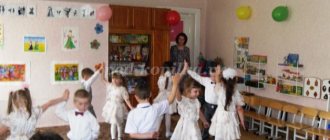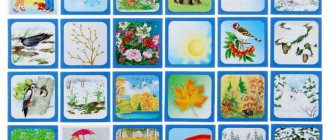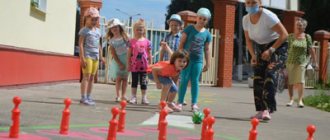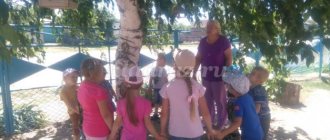Winter fun
The main winter folk holidays that children and adults look forward to: a fabulous and cheerful New Year, a magical Christmas, a mysterious Epiphany.
Since ancient times, the New Year has been celebrated in Russia on January 1. On this day, everyone anxiously awaits the visit of the main character of Slavic fairy tales - Grandfather Frost - a kind wizard who brings gifts.
Svyatki (Holy evenings) on New Year's days This is the name of the days of celebration, fun and sacred celebration of the Nativity of Christ .
Since ancient times, at this time, all kinds of costumes were made and put on (animals, mythical heroes, fairy-tale characters), which developed into real colorful masquerades, during which carols were sung, and the mummers jokingly congratulated relatives, friends, and neighbors on the bright holiday.
This custom is very popular in preschool institutions. Children happily try on different images and dance around the Christmas tree.
Two weeks after Christmas, another significant holiday was celebrated - Epiphany , dedicated to the greatest event of the baptism of Jesus Christ. It was believed that on the night of the celebration, the water in all sources became holy and relieved people of illnesses. To take advantage of the miraculous properties of water, people plunged into the ice hole.
Educators can achieve the goals of instilling a respectful attitude towards the traditions of the Russian people and introducing children to the culture of winter holidays through various events, for example:
- “New Year's round dance” (matinee with a meeting of Santa Claus, round dance around the Christmas tree, congratulations, gifts, costume masquerade);
- “Snow fights” (street games with throwing snowballs, making a Snowman, painting on the snow, winter sports competitions);
- fabulous theatrical performances: “Morozko”, “New Year’s Tale”, “Winter Hut of Animals”;
- festive winter gatherings (group activities using riddles, proverbs, poems, songs, signs, illustrations).
Spring is red
The Russian people also celebrated spring holidays on a grand scale. The onset of spring is marked by the arrival of Maslenitsa .
Each day of Maslenitsa week has its own name, games and customs. On these days they baked pancakes, went to visit people, organized all kinds of games, fist fights, and booths for buffoons.
The main attribute of the celebration was the Maslenitsa doll, which was made from straw and burned in a fire on the last day, asking each other for forgiveness.
Today, kindergarten employees are reviving these traditions with great enthusiasm, holding Maslenitsa festivities with children. With songs, round dances and nursery rhymes, the children enjoy pancakes and take part in Russian folk games.
Spring Christian holidays are no less interesting: Annunciation, Easter, Palm Sunday , which are accompanied by ancient rituals.
Spring folk holidays in kindergarten can be held using folklore material.
- “Seeing off Maslenitsa” (ritual of burning the Maslenitsa effigy, songs and round dances on the playground, serving pancakes);
- “Musical grain” (dramatization of the ceremony of sowing grain accompanied by songs, playing musical instruments: accordion, pipe, balalaika, wooden spoons);
- “Wake up, Red Spring!” (games and competitions on the street, releasing birds from cages into the wild, round dances, ditties);
- thematic classes in a group (crafts made from natural materials, coloring Easter eggs, skits about spring).
Scenario of the costumed crafts fair “In the village of Filimonovo”
The folklore holiday was prepared by employees of kindergarten with an ethnocultural Russian component of education No. 2096 ZelAO of Moscow:
- additional education teacher Susanna Israelovna Saribekyan,
- musical director Bobrovich Margarita Aleksandrovna.
Target
Introduce children to the folk toy Filimonovskaya, the method of making it and painting it with yellow-red-green stripes. Learn to look at clay toys, highlight the material - clay, toy decorations, elegance, brightness. Create a joyful mood from a meeting with a folk toy, enhancing the impression by using folklore works and costumes.
Hall decoration
Autumn picture of the village: a hut, a well (the roofs are painted with Filimonov patterns), trees decorated with leaves to match the Filimonov painting; Grandfather Philemon is sitting on a bench under a tree. Tables with patterns and figures are hung. Prepared
- a table on which Filimonov’s toys are placed: a rooster, a cow, a soldier, a madam, a poultry woman, a horseman; rotating carousel with figures;
- goods for the fair: bagels, beads, handkerchiefs.
Ah, summer!
In June, the people of Russia celebrated the main summer holiday - Ivan Kupala . The ancestors celebrated this event very cheerfully: they played the harp, danced in the grove and forest, jumped over fires, wove wreaths from herbs, and made wishes.
The main plant - a symbol of the celebration - is the fern, which, according to legend, blooms on this day.
Modern children love spending holidays in the lap of nature.
A beautiful patriotic holiday of Ancient Russia - Trinity (the holiday of flowers and birch trees). The main heroine of the holiday is Birch. Quizzes, competitions, and drawings by children are dedicated to her.
Thus, summer folk holidays should not be ignored.
- “Kupala” (learning the skill of weaving wreaths, studying plants, reading fairy tales about mermaids);
- “Russian birch tree” (carrying out a ritual with tying ribbons on a birch tree and making wishes).
Autumn feast
Autumn is the time of harvest and the departure of birds. The ancient Slavs celebrated numerous autumn holidays and performed rituals. Basically, they were all dedicated to thanksgiving to Mother Earth for the harvest. The most significant holiday is Autumn .
Studying such traditions helps to instill in children a love of work, nature, and to become familiar with the process of cultivating various garden crops. There is an opportunity to find out what clothes our ancestors wore when they worked the land, what clothes they wore when they sat down at the table, and what costume they wore for festive ceremonies.
- “Autumn Harvest Fair” (feast, quizzes on the topic);
- “Folk costume fashion show” (study of the details of Slavic clothing, competition - fashion show).
During such events, preschool children not only comprehend the spiritual traditions of their people, but also actively take part in active ancient games: tug of war, leapfrog, burners, towns.
It is extremely important for teachers to hold folk holidays in kindergarten. Through folklore, children are instilled with love for the Motherland and are given knowledge about the cultural traditions of the people.
Family folklore festival for primary schoolchildren. Scenario
Scenario for a family folklore event “Evening Gatherings”
Description: The scenario can be used by primary and secondary school teachers, teacher organizers, and additional education teachers to conduct extracurricular activities for children from 7 to 14 years old and their parents. Goal: creating conditions for creative, collective development, self-realization and strengthening of the family, class, creative association. Objectives: - fostering love for the traditions and culture of the Russian people; — organizing joint leisure time for children and parents in the classroom, creative association. — preservation and development of family traditions; — intensification of the creative activity of teachers who collaborate with families in the education system; — formation of a bank of methodological materials devoted to issues of organizing cooperation with the family. Decoration: The classroom is decorated in the style of a village hut.
Part of the room is occupied by a prop chest, a table with a samovar, benches for children, and various folk attributes. This area will be the stage area where the main action will be concentrated. The other part of the office is the auditorium, where there are seats for parents and guests. All seats are divided into two zones and indicated by signs - Khlopushkina Street, Topotushkina Street. Action before the event:
All guests are greeted in the foyer by children in Russian folk costumes, lined up in a corridor. Each guest is greeted with a bow and kind words. Next, the teacher, upon entering the office, invites everyone to the “hut” for the evening. The teacher plays the role of the Mistress. Guests pull a ribbon from the basket she offers, thus determining which street they came from. Accordingly, two teams are immediately formed, and guests are seated according to the team names and signs. Before the start of the event, a musical selection of folk songs is played.
Progress of the event:
Music in the background Hostess: All the guests have arrived!? Guests: Yes! Hostess: We can start the evening! Is Khlopushkin Street here? Guests: Yes! (clap their hands) Hostess: And Topotushkin Street? Guests: Yes! (stomp their feet) Hostess: And the residents of Veselushkina Street? Guests: No! Hostess: Oh, they're late again! Okay, let's wait! The hostess sits down at the table while waiting and sings the song “Oh, my dove, my dove.” There is a knock on the door. 1 child appears with a basket in his hands.
1st child: Can I come to you? Hostess: Yes, yes, dear Katyusha! 1st child: Hello, Mistress! Hostess: Hello, Katyushenka! Today you were the first to come to me from Veselushkina Street for the evening. 1st child: I was in such a hurry! My mother told me at lunchtime that we would have a party at your place. Strange?! And there is no one from our street yet. Hostess: Probably they wash in the bathhouse. Well, come in and settle down. My room is spacious, bright, clean, there is enough room for everyone. 1st child: And the floor is strong. It won't break! Eh, I'll break the floor! I'll break the ceiling! I’ll stay on the board, I won’t part with my dear one. Hostess: Who do you love? 1st child: Yes, I like Romka from Zarechnaya Street. Hostess: Nice guy! What did you bring in such a big basket? 1st child: Kudelka. Sits down next to the Mistress. They begin to unravel the knot. There is another knock on the door, and the rest of the children appear with noise and laughter. 2nd child: Can the hostess come to your place for the evening? Hostess: Hello, girls! Come in, sit down on the benches, take out your handicrafts, and start a song. It’s easier to work with a song. They sing the song “The grapes are blooming.” Music in the background Hostess: Well, tell me, who strained and wove what? Child 3: I’m embroidering a towel. Hostess: Yes, are you planning to get married? 3rd child: No. It's too early. I'm just preparing the dowry. Child 4: I knitted some downy socks. They say the winter will be cold today. Child 5: Can you knit these for me? 4th child: I would sit down and knit it myself! Child 5: But my heel doesn’t work. 4 child: Come to the next party, I’ll teach you. Child 6: And I’m spinning cords. Child 7: Yes, you’ve been spinning this piece of yarn for a whole week. Child 8: I sewed a shirt for Vasily. Child 9: Yes, your Vasily will be the most handsome guy in the village in this shirt. Child 10: The shirt is just like a shirt. The most ordinary. I can sew one like this too. Child 9: But you haven’t held a needle in your hands. You come to the party just to husk the seeds. Child 8: Girls, you are all about work, yes about work. I already want to play! Hostess: And that’s true. Why not play! Russian folk game “Golden Gate”: Residents of all streets are invited. Two parents are selected, who stand facing each other and raise their hands up, indicating the gate. The remaining players take each other's hands to form a chain. Everyone sings the words in chorus, and the chain must quickly pass under the gate: Golden Gate Come through, gentlemen! The first time is forgiven, the second time is forbidden. And the third time we won’t let you through! With these words, hands drop and the gates slam shut. Those children and parents who are caught become additional gates. The "Gate" wins if they manage to catch all the players. There is a loud knock. Rustle in the chest. Music in the background Mistress: Oh, who's rustling in the chest?! The mouse must have gotten wound up! Let's ask the strongest guy in the village to open the chest and catch her! Dad opens the chest and Kuzya the brownie appears from it. Usually at this moment all the children begin to squeal in surprise. Brownie: Oh, oh, oh...Oh, oh, oh, oh, sad...Where can you hide here...There is no underground, no closet, no, no crack, no hole...oh, oh.. Well, you can’t hide anywhere from your noise! You won't let me sleep! By the way, I am an honored brownie, I have been living in your community for a long time, helping with the housework! Either I'll sole the suit, or I'll sweep the hut! And you... What kind of Sabantuy have you staged here, huh? Hostess: We’re having a party today! Guests from all over the village gathered! Brownie: Evening, you say? Well, this is a good thing! Firstly, you can show yourself in all your glory, secondly, you can play and compete, and thirdly, you can show off your craftsmanship! After all, whoever doesn’t work is just pretending! And whoever is pretending is still pretending! In general, in our opinion: He who does not work, does not eat! Well, first of all, let me introduce you! (takes out a bast shoe from the chest, maybe two bast shoes) GAME “My name is... And today I am the most...”: All participants stand in a circle. While the music is playing, you need to pass the bast shoes from hand to hand. As soon as the music stops, whoever has the bast shoe in their hands, go out into the circle and loudly say the phrase: My name is... And today I am the most...! For example, My name is Nikolai, and today I am the most cheerful! Each participant comes up with their own interesting continuation. Music for the game Music in the background Brownie: So we met! And now I want to see what kind of needlewomen and craftsmen you all are! I wove this kind of scarf at night (points to the wall where the base of the scarf hangs), but the problem is that there are no patterns on it! And they will be able to appear only thanks to your good mood, joyful smiles and fiery energy! What is the best thing to lift your spirits? Of course, a good song! COMPETITION “BATTLE OF THE CHOIRS”: Residents of each street take turns singing excerpts from songs on a given topic. It is advisable to use a button accordion. Music for the competition Music in the background Brownie: Well done, thanks to your wonderful songs and friendly choir, the first colorful patterns appear on the scarf! (gives out patterns from the chest to mothers and some children, they attach them to a scarf) Oh, I look at you, and it seems to me that you’ve been sitting too long! It's time to get some exercise! I invite fiery dancers from every street! Let's test this floor for strength! “CROSS-DANCE” COMPETITION Each team is invited to come out and dance a fiery dance to the proposed music. It is best to choose musical compositions of different character, for example, round dance, dance, etc.
Music for the competition Music in the background Brownie: Oh, I think the head of the district heard us in another village! Get more painted patterns! (attached to a scarf) And of course, what would an evening be without hot hugs! I announce a hug relay race! “HUG RELAY” COMPETITION: Each team passes hugs from the first person to the last person in the chain. The last participant runs up to hug Domovoy. Whose team hugs the brownie the fastest wins. Music for the competition Music in the background Brownie: From your hot and strong hugs, such patterns blossomed that I’m simply amazed! Come on, needlewomen, paint the carpet with the finishing touches! Let's applaud each other, because together we were able to create such a collective work with our creativity, talent and good mood - a real Russian scarf! The most important thing is that the scarf is magical: if you suddenly feel sad, then as soon as you touch it, your soul will be filled with joy and you will immediately want to sing! (touches the scarf)…oh…I really want to!! Come on, girls, help, start a song!
Children sing the folk song “Nikanorikha”. You can sing in chorus any song that would be familiar to all guests! Music in the background Brownie: Well, as they say, a hut is red not in its corners, but in its pies! I hasten to treat you to delicious talismans that will bring only good luck to your homes! Accept with all your heart this symbol of good luck - the horseshoe! (he treats you to cookies in the shape of a horseshoe; you can attach predictions to them) I ask everyone to come to the table for the samovar!
Tea party.
We recommend watching:
Scenario for a holiday in an elementary school “Oh sport, you are the world” Family holiday in a correctional school. Scenario Tea Festival in elementary school. Scenario Flower Festival in elementary school. Scenario
Similar articles:
Class notes in elementary school. My family
Celebrating farewell to the school year. Scenario
Humorous skits for elementary school children
Lyceum Day. Scenario for elementary school
Extracurricular activity in elementary school. Folk crafts of Russia






